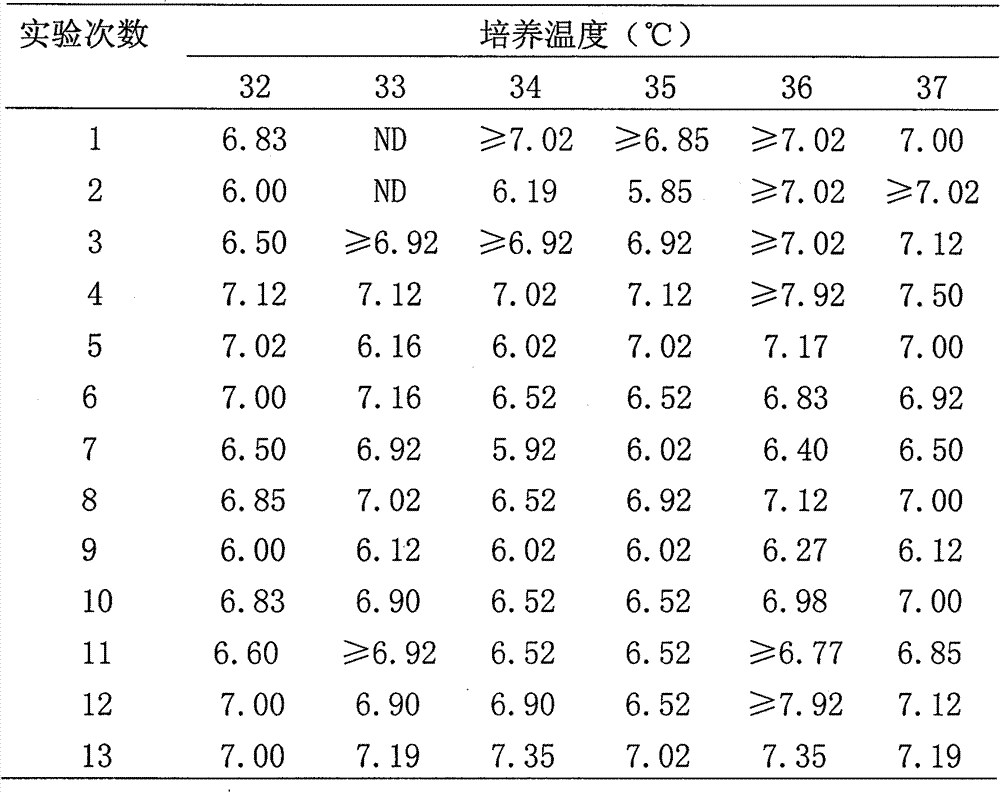Human diploid cell rabies vaccine virus seed and preparation method thereof
A technology of human diploid cell and rabies vaccine, applied in the biological field, can solve the problems of high vaccine cost, high price, low virus titer, etc., and achieve improved safety, major social and economic benefits, and good immunogenicity. Effect
- Summary
- Abstract
- Description
- Claims
- Application Information
AI Technical Summary
Problems solved by technology
Method used
Image
Examples
Embodiment 1
[0020] Human diploid cells (KMB17) were cultured and amplified at 35° C. to 37° C. with a cell nutrient solution composed of Eagle solution, milk protein and 2% to 15% newborn bovine serum. When the cells grow into a dense monolayer, they are digested with trypsin-EDTA, the cells are collected, and CTN-1V 5 The strain is inoculated in human diploid cells (KMB17) by the suspension cell inoculation method at a dose of 0.005-1.0 MOI, cultured at 32°C-37°C, pH 7.2-8.0, and the virus is harvested after 2-20 days of culture, that is, fixed rabies virus. CTN-DK1, and continued passage in the same way. When subcultured to CTN-DK20, the virus with higher titer was screened by the final dilution method and continued for 9 passages, named CTN-DK29, and then screened by the final dilution method of CTN-DK29 and passed for 4 generations, named CTN -DK33, and then selected by the final dilution method with CTN-DK33 and passed to 47 passages. CTN-1V 5 The strain was continuously passaged ...
Embodiment 2
[0022] Using the suspension cell inoculation method, take the cells that have grown into a single layer, digest them with trypsin routinely, collect the cells, and then suspend them in a growth medium (Eagle lactalbumin culture medium containing 10% to 15% newborn bovine serum) at an appropriate ratio cell. Inoculate the virus in suspension cells, culture at 37°C until the cells grow into a monolayer, remove the original culture medium, replace with maintenance medium (Eagle lactalbumin culture medium containing 2% to 5% newborn calf serum), and place at 32°C, Cultivate at 33°C, 34°C, 35°C, 36°C, 37°C, and harvest the virus liquid after 5-7 days. The harvested virus liquid was detected by rabies virus titer titration test (LD50), and the results are shown in Table 1.
[0023] The virus titer (1gLD50 / ml) of table 1 virus kind in different cultivation temperature in human diploid cell (KMB17)
[0024]
[0025] The above data were tested by T test, 0.2
Embodiment 3
[0027] In order to determine the optimal inoculum amount of virus species, experiments were carried out on different multiplicity of infection (MOI) of rabies virus fixed virus CTN-DK strain infecting human diploid cells (KMB17). The method is to make the KMB-17 cells growing in the logarithmic phase into a cell suspension and count them. Inoculate the suspension cells with the titrated virus at 1.0, 0.5, 0.1, 0.05, 0.01, 0.005 MOI, culture at a suitable temperature, and harvest the virus liquid after culturing for a certain period of time. The harvested virus liquid was detected by rabies virus titer titration test (LD50), and the results are shown in Table 2.
[0028] The virus titer (1gLD50 / ml) of table 2 virus kind different MOI infection human diploid cells (KMB17)
[0029]
[0030] The results showed that there was no significant difference in the production of cells infected with different numbers of viruses. Therefore, it is more appropriate to use 0.005-1.0 MOI to ...
PUM
 Login to View More
Login to View More Abstract
Description
Claims
Application Information
 Login to View More
Login to View More - R&D
- Intellectual Property
- Life Sciences
- Materials
- Tech Scout
- Unparalleled Data Quality
- Higher Quality Content
- 60% Fewer Hallucinations
Browse by: Latest US Patents, China's latest patents, Technical Efficacy Thesaurus, Application Domain, Technology Topic, Popular Technical Reports.
© 2025 PatSnap. All rights reserved.Legal|Privacy policy|Modern Slavery Act Transparency Statement|Sitemap|About US| Contact US: help@patsnap.com



